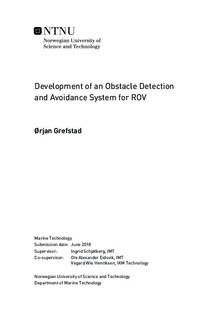Development of an Obstacle Detection and Avoidance System for ROV
Master thesis
Permanent lenke
http://hdl.handle.net/11250/2564475Utgivelsesdato
2018Metadata
Vis full innførselSamlinger
- Institutt for marin teknikk [3432]
Sammendrag
Unmanned underwater vehicles, such as remotely operated vehicles (ROVs) and autonomousunderwater vehicles (AUVs) are commonly used for inspection, maintenance and repair(IMR) missions in the oil and gas industry. This is a cost-driven industry and advances inautonomy is a key factor to reduce the mission expenses.Collision avoidance is one of the main challenges in the field of AUVs. In this thesis asystem for detecting obstacles and planning a new path around the obstacles is proposed.The system is divided into three modules: an object detection module, a collision avoidance module and a guidance module.The object detection module uses a single-beam mechanically scanning sonar to populate a probabilistic occupancy grid. The sonar data is related to the probability of occupancy through a dynamic inverse-sonar model. The occupancy grid is vehicle-fixed andthus position or velocity data is needed for translating and turning the grid. The translationand rotation is archived using an image processing technique known as affine transformation.A global occupancy grid has to account for the growth of the positional uncertainty,and thus the accuracy of the map will fall over time. With a local map the obstacles will becorrectly located with respect to the vehicle, which is sufficient for the purpose of collisionavoidance. The obstacles are detected through a contour detection algorithm. The detectedcontours are then expanded to make a safety margin around the obstacles.The collision avoidance module compares the current path with the detected obstaclesand initiates a path recalculation if they coincide. The path recalculation is done witha combination of Voronoi diagrams and a modified version of Dijkstra s shortest pathalgorithm. Once a new path is calculated, it is smoothed using Fermat s spiral and sent tothe guidance system.The guidance system is a classic line of sight guidance scheme, with a velocity dependent lookahead distance. The velocity guidance uses the path curvature as an inputparameter. This enables the guidance system to reduce the commanded velocity whensharp turns are detected.Several simulations were performed and the complete system was tested on a ROVstationed on the Snorre B oil field. During the field experiments, it was confirmed thata mechanically scanning single-beam sonar is sufficient as the only sensor for detectingand avoiding obstacles in an underwater environment. The technology is also applicableto AUVs as the calculated paths have a continuous curvature.Regarding further developments of this system, it is suggested to look into other guidance schemes, such as trajectory tracking. The object detection system would benefit fromintroducing additional sensors, such as cameras for detection of close obstacles.
